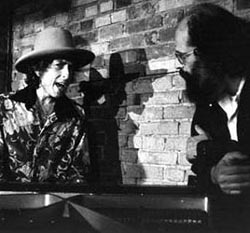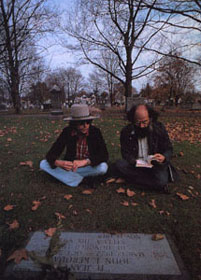| Both Charlie Patton
(1892-36) and Son House (1902-89) were famous for "Pony Blues," and both
of them were also blues singers who were convinced that blues was the "Devil's
music." At certain times during their lives, they both gave up blues singing
to become lay preachers - though they also both backslid and returned to
the blues (among other unpreacherly activities). In his later performances,
Son House was always careful to include at least one gospel number amid
the blues songs to "sanctify" proceedings.
"New Pony" explores
this ambiguous relationship, contrasting the deep blues of the song with
the gospel chant of "How much longer?" Dylan's song is based on House's
version, not Patton's.
However, the House
version sprung from Patton's, which is certainly one of the finest country
blues performances ever recorded. Dylan himself was "born again" in November
of this year, and the tension between the attractions of the flesh and
the spirit is made tangibly real.
| You know, the horse
that I'm riding, he can fox-trot, lope and |
| pace Hmm, he can
fox-trot and lope and pace Y'know, a horse |
| with that many
gaits, y'know, booked to win that race. |
| Pony Blues |
| I got
a new pony, she knows how to fox-trot, lope and pace Well, I |
| got a new pony,
she knows how to fox-trot, lope and pace She got |
| great big hind
legs and long black shaggy hair hanging in her face |
| New Pony |
|
 The
following quotes come from the site called "Dylan
influences" written by Matthew Zuckerman. Zuckerman states, "Bob Dylan
is one of those musicians who absorbed the old traditions, kept them alive,
and extended them. What follows is an admittedly incomplete list of songs
written by Dylan for which he took inspiration from other songs, traditional
or otherwise. The amount of "inspiration" varies from song to song - it
might be a tune, barely altered, or just a fragment from a tune; it might
be a verse or a couplet, or just a distinctive turn of phrase."
The
following quotes come from the site called "Dylan
influences" written by Matthew Zuckerman. Zuckerman states, "Bob Dylan
is one of those musicians who absorbed the old traditions, kept them alive,
and extended them. What follows is an admittedly incomplete list of songs
written by Dylan for which he took inspiration from other songs, traditional
or otherwise. The amount of "inspiration" varies from song to song - it
might be a tune, barely altered, or just a fragment from a tune; it might
be a verse or a couplet, or just a distinctive turn of phrase."



